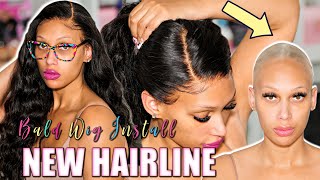The Expert Guide on How to Secure a Wig

The 7 Best Ways to Secure a Wig
It is a fact universally acknowledged that a woman wearing a wig is afraid her wig will fall off.
Who can blame her?
Wigs falling off, blowing off, sliding off, getting ripped off, and sliding around are the number one fear of wig wearers worldwide.
Learning how to secure your wig correctly - really, really secure it - will make you more confident while you wear your wig.
But there’s more than one way to secure a wig, and not all methods work for every woman.
This guide will walk you through the seven best ways to secure your wig and how to figure out which method works best for you.
Method #1: Wig Tape
*Before we talk about wig tape, we give a quick disclaimer: if you wear a wig on top of natural hair, you should never use wig tape.
Wig tape can rip out hairs when you remove it. While it’s true that wig tape is one of the most effective methods of securing a wig, it’s not worth the damage to any existing hair you have.
So if you still have hair on your head and you’re worried about hair loss, move on to the next method.
Wig tape is double-sided tape that adheres to your head on one side and your wig on the other.
People who use wig tape prefer it because wig tape is as close to a guarantee that you can get that your wig won’t fall off. Wig tape works, which is why performers and Hollywood professionals prefer it above any other application method.
How to Use Wig Tape
Step 1: Soak a cotton ball with rubbing alcohol and wipe it along your hairline. This cleanses your skin and removes any dirt or oils that could stop the tape from sticking to your skin.
Step 2: With a new cotton ball, apply a thin layer of liquid band-aid to the area just below the hairline. This prevents the wig tape from damaging your skin. This step is especially important for women with sensitive skin or who work out with their wig.
Step 3: Cut the wig tape into several strips if using a roll of tape. Peel away one side of the paper from the wig tape and place each strip on the perimeter of your hairline, starting at the front of your head and working towards the nape of your neck.
Step 4: Remove the paper from the front strip. Place the front of the wig along the exposed piece of wig tape and press firmly to secure.
Step 5: Working from front to back, remove the tape one strip at a time then press the wig onto the exposed tape. Make sure you pull the wig firmly as you attach it to each section of the tape.
Step 6: Step back in the mirror and admire your handiwork.
Pros & Cons of Wig Tape
PROS
• Wig tape comes in various forms: a roll, pre-cut strips, and spot tabs. You can experiment with all three styles until you find the one you like the most.
• Some wigs come with polyurethane tabs, specially designed for wig tape, and guaranteeing a strong grip.
• Wig tape makes your wig very secure. If you work out while wearing your wig or are going to a big event, wig tape will take the worry out of wearing a wig.
• A roll of wig tape lasts a long time! Because of that, wig tape is a great budget-friendly option.
CONS
• Some women like to remove their wig throughout the day to cool their head. If you’re wearing wig tape, taking off your wig throughout the day can be tricky.
• Because your wig is taped down to your head, it makes it easy to overheat. If you have problems with overheating or if you’re going through chemotherapy, wig tape might not be the best choice.
• Wig tape can be difficult to remove. There are liquid solutions that help gently remove wig tape, but if something gets stuck the removal process won’t be easy.

Method #2: Wig Glue
* Like with wig tape, wig glue should only be used by people without hair. As with wig tape, wig glue is an extremely secure method of wig attachment, and you could potentially rip out hairs when you remove it.
If you have hair or sensitive skin, avoid wig glue.
Wig glue is a roll-on adhesive that is clear and won’t leave stains. Wig glue is easily removed with water and is pliable (it will move with your skin rather than staying stiff in one area).
As a bonus, you can use your wig glue to secure other things, like pantyhose, socks, nylons, shoulder straps, or orthopedic devices.
How to Use Wig Glue
Step 1: Put some rubbing alcohol on a cotton swab and run it along your hairline to remove any oil, dirt, or makeup buildup that can stop the glue from fully adhering to your skin.
Step 2: Roll on a thin layer of wig glue along your hairline. Depending on the type of wig glue, you may need to allow it to dry a little before attaching your wig. Follow the instructions on the package.
Step 3: Place the front of the wig on top of the glue, followed by the sides and then the back of the wig. After you’ve situated the wig, lightly press the wig down onto the glue. Wait for it to dry for at least 10 minutes before styling.
Pros & Cons of Wig Glue
PROS
• Like wig tape, wig glue lasts a long time (if you’re careful and aren’t applying too much!). Wig glue is an inexpensive wig application option.
• Wig glue is an especially effective and 100% secure until you remove it.
• Wig glue is easy to apply! Simply roll it on, put on your wig, and go!
CONS
• If you like to remove your wig throughout the day to cool down, you might not want to use wig glue. Removing and reapplying a wig with wig glue can be time-consuming and difficult.
• Wig glue will “suction” your wig to your head, causing oils to build underneath the wig. If you have sensitive skin, those oils can cause skin issues.
• Because wig glue keeps your wig so tight, it can be easy to overheat. If you have issues overheating while wearing a wig, avoid wig glue.
• If you don’t apply enough water or solution when you’re taking off your wig, you can rip or tug at the skin.

Method #3: Silicone Solution Sheets
Silicone solution sheets are - as the name implies - sheets of silicone. They come with a needle and invisible thread, and the solution strip is then sewn into your wig to create a wig grip inside the wig.
How to Use Silicone Solution Sheets
Step 1: Remove the sheet from the tin and cut it into strips that fit the circumference of your wig.
Step 2: Sew the first strip into the front of the wig, being sure to sew on both sides. Don’t be lazy with your stitches; these strips are what’s going to hold your wig in place! Repeat this process, going front to back until you’ve covered the entire wig.
Step 3: Secure the wig to your head.
Pros and Cons of Silicon Solution Sheets
PROS
• Silicone solution sheets let you sew a wig grip into your wig. A wig grip that will never stretch out or fall off, no matter how many times you wear your wig.
• Like a wig grip, silicone solution sheets are flexible. They move with your skin so your wig will never feel too tight.
• Silicone solution sheets are economical because they last the entire life of your wig and never need to be replaced.
CONS
• If you don’t know how to sew, either take a sewing class or avoid silicone solution strips. If you rip or tear your wig while you’re sewing in the sheets, you could ruin your wig forever.
• Silicone solution sheets suction to your head. Underneath that suction, your head can overheat. If you’re prone to overheating, these sheets aren’t the best option.

Method #4: Wig Grips
Wig grips are one of the most popular methods for securing a wig. They are perfect for women with or without hair and are easy to use.
Wig grips can be worn under any wig, hat, or scarf, and will keep them completely secure. Made of double-sided velvet, wig grips are designed with one side that grips your hair or skin and one side that grips your head cover or wig.
Most wigs grips come with an adjustable strap at the back that allows you to readjust the size of the grip.
How to Use a Wig Grip
Step 1: Secure all of your hair to your head. Make sure you use hairspray or gel to flatten any flyaway hairs to your scalp.
Step 2: Place the wig grip on top of your hairline and use the velcro strap at the back to adjust the grip.
Step 3: Gently place your wig on top of the wig grip, starting by placing the front of the wig on your head, then the sides, then finally the bottom.
Step 4: Shake your head a little side to side to make sure your wig grip isn’t too loose. If it is, remove the wig and start over.
Pros and Cons of Wig Grips
PROS
• Wig grips are easy to take on and off. If you need to remove your wig throughout the day to cool off, wig grips are a great choice.
• Wig grips won’t rip out your hair when you remove them, so wig grips work well for women who are trying to regrow hair.
• Wig grips alleviate pressure and can help with headaches or pain.
CONS
• If the adjustable strap on the back of your wig grip breaks or becomes loose, your wig could fall off in the middle of the day. This is rare, but something to be aware of. Keep an extra wig grip in your purse in case of emergencies.
• Wig grips stretch out over time and need to be replaced every so often, depending on how often you wear your wig. Because quality wig grips can run upwards of $20 each, they can be a pricey choice.

Method #5: Wig Caps
Wig caps are perfect for people who have hair or those that don’t. Wig caps sit on top of your head underneath your wig and grip to your skin on the inside layer.
There are three main types of caps:
• Nylon Wig Caps
• Mesh Wig Caps
• Wig Grip Caps
Nylon Wig Caps are best for women with shorter hair or no hair because they provide a smooth surface against the skin.
Mesh Wig Caps are best for women with long hair because they’re good at flattening and collecting long hair.
Wig Grip Caps are best for women who like the security of wig grips, but have sensitive skin and need a layer between their wig and their skin.
How to Use Wig Caps
Step 1: Dab a cotton ball in rubbing alcohol and run it along your hairline, whether or not you have hair. This removes oils, makeup, and dirt that can make a wig cap slip around.
Step 2: Put both your hands inside the wig cap and stretch the cap slightly. Place the cap on your head, starting at the front and working your way to the back.
Step 3: Smooth out the cap to make sure there aren’t any air pockets.
Step 4: Place the wig on top of the cap the same way you put on the cap, with two hands inside the wig, starting at the front and working your way towards the back.
Pros and Cons of Wig Caps
PROS
• Wig caps create a barrier between your scalp and your wig. This keeps your wig clean and free of any oil buildup.
• For women with hair, wig caps keep your hair in place underneath your wig.
• In cold weather, wigs keep you warm, and a wig cap can add an extra layer of warmth.
CONS
• Wig caps stretch out over time and need to be replaced, otherwise you risk the cap (and your wig) slipping off your head.
• In hot climates, or for women undergoing treatment, wig caps can make you even warmer.
• Sweat and oil can build up in a wig cap and if the cap isn’t properly cleaned it can start to smell like sweaty gym clothes. Not a great smell.

Method #6: Bobby Pins
*Note: you must have a significant amount of your own hair to use bobby pins.
Attaching your wig with bobby pins is one of the oldest wig attachment methods in the book. If you’re in a bind, not near a beauty supply store, and need a quick way to attach your wig, bobby pins are a great choice.
How to Use Bobby Pins
Step 1: When you purchase your bobby pins, make sure you match them to the color of your wig, otherwise they will be visible underneath the wig.
Step 2: Collect all of your hair and make sure it is all tied down. Use hairspray or gel to tame flyaways.
Step 3: Put two hands inside the wig and place it on your head, putting the front of the wig on first and working your way towards the back.
Step 4: Lift sections of your wig, starting at the front, and place the pins through the wefts of the wig and into your own hair. Make sure you put in enough pins to completely secure the wig.
Pros and Cons of Using Bobby Pins
PROS
• Bobby pins are cheap. You can purchase a pack at most grocery stores for less than a dollar.
• Bobby pins won’t suction your wig to your head, so your head is less likely to overheat underneath your wig.
• Best of all, bobby pins are great for women with sensitive skin. There is no fabric involved that could irritate sensitive skin.
CONS
• If you’re not careful when you’re inserting your bobby pins, they can poke at your head throughout the day and make you uncomfortable.
• If you don’t use enough bobby pins, your wig can come loose during the day. Make sure you use enough pins to keep your wig fully secure.

Method #7: Wig Clips
To use wig clips you need two things: natural hair and sewing skills.
Wig clips are sewn into the cap of the wig and then clip into your hair. They are a great long-term option because once they’re sewn in, you’re good to go for the life of your wig.
How to Use Wig Clips
Step 1: Wig clips typically come in packs of 12, but that doesn’t mean you’ll need all 12 for one wig. Sew the clips into the wig, starting at the front of the wig and working your way towards the back, leaving one inch of space between each of the clips.
Step 2: Pull your hair back off your hairline and gather it at the nape of your neck. Be sure to use hairspray or gel to tame any flyaways.
Step 3: Starting at the front, slide the clips into your hair. Shake your head side to side to make sure everything is secure; then you’re good to go!
Pros and Cons of Wig Clips
PROS
• Once they're sewn in, wig clips never need to be replaced. Hellow, money-saver.
• Wig clips grip onto your natural hair without pulling any out.
CONS
• If you don't know how to sew, don't use wig clips. The wig clips are only as secure as you sew them. Not only that, if you damage your wig while sewing in the clips, your wig could be damaged forever.
• Some people complain that wig clips scratch their head. If you have sensitive skin, wig clips can irritate it.
Want to learn more about how to take care of your wig? Read our posts on What You Need to Think About BEFORE You Buy a Wig Cap and How to Make a Wig Look Real.
What’s your favorite wig application method? Let us know in the comments!




